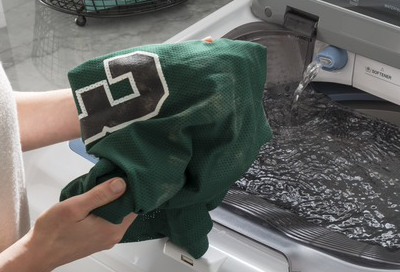
Laundry is stained or damaged after using Samsung washing machine

It can be frustrating to have clothes come out worse than when you put them in the washing machine, but in the vast majority of cases, any stains or damage that weren't there when you put them in the washer, aren't actually caused by your washer. Routine maintenance and cleaning, combined with the proper use of additives, will often correct and prevent the issue.
Fabric softener stains

Oily stains will occur if:
- Softener is poured directly onto clothes
- Softener is put in the incorrect compartment in the detergent drawer
- Fabric softener exceeded the MAX line
- Too much softener is used (exceeding the manufacturer's recommended amount for the load size)
- The detergent drawer is dirty or obstructed
In the vast majority of cases, using the correct amount of softener in the correct compartment will resolve the issue.
If the issue does continue, use a different type or brand of fabric softener. Service is not required.
Rust stains or brown flakes

Yellow, orange, or red stains may be caused by iron or manganese in the water supply, or from rusty water heaters and pipes.
If this stain occurs, the most common reason is the home's water supply. Follow the steps to test your water supply in the section Additional troubleshooting for all stains.
The few situations where the washer itself can form rust are typically on the outside surfaces of the washer or in other areas that laundry would not come in contact with during a wash cycle. Any form of rust-like stains inside the washer's drum or tub is likely due to the water supply just like the stains on the clothes are and should clean off easily if treated immediately.
However, if you determine the washer itself is rusty, whether it's staining your clothes or not, contact us.
Bleach stains

Permanent white blotches on colored fabrics will occur if:
- Bleach is poured directly onto clothes
- Bleach is put in the incorrect compartment
- Bleach exceeded the MAX line (not all models have a MAX line)
- Too much bleach is used (exceeding the manufacturer's recommended amount for the load size)
- The detergent drawer is dirty or obstructed (some models do not use the detergent drawer for the bleach compartment)
In most cases, using the correct amount of bleach in the correct compartment will resolve the issue.
If the issue does continue, use a different type or brand of bleach. Service is not required.
Hard water stains

Dull gray or white stains (which are not permanent like bleach stains) could be due to:
- Elevated levels of calcium in the water
- A chemical reaction between liquid softener, detergent, and suds, which can create a white deposit on clothes
First, see if the residue occurs even when no additives are used. If it does, this means your water supply is the source of the issue. Service is not required.
If the issue only happens when you use additives, then they are the source of the issue. Again, service is not required. Use a different combination of additives that are designed to work together, preferably from the same manufacturer. Contact the manufacturer(s) of the additives for additional assistance.
Mold stains

Spots of brown, gray, black, or green develop if clothes are left in a damp environment. Always empty the washer as soon as possible after the cycle has finished, and perform routine cleaning and maintenance of the washer to prevent these types of stains.
See our guide for Washer has a mildew smell or visible mold for an in-depth guide on cleaning this.
Additional troubleshooting for all stains
These steps can be performed for any type of stain. However, the specific steps for the type of stain you have (if applicable) should be performed first.
- Check if pens, markers, paint brushes, crayons, or any kind of ink/dye that could stain clothes are in the washing machine or in the pockets of clothing.
- Make sure you don't exceed the MAX line in any compartment.
- Don't exceed the manufacturer's recommended amount for your load size either, even if it's less than the MAX line. The excess additive may cause stains and other issues.
- Keep the washer clean. The detergent drawer can especially contribute to stains if it is not kept clean.
If you're still having issues or seeing any kind of residue in the wash, perform the following:
- Disconnect your water supply from the washer and pour water from it into a bucket. If there's residue in your water supply, contact a plumber for assistance.
- Run an empty cycle without adding any detergent or additives, and if you see the residue, then run two more empty cycles. This can flush out any residue that's still in the washer. If you still see residue after the third empty cycle, visit our Support Center to request service.
- If you don't see residue when you run an empty cycle, but you see it when you're doing laundry like usual, whatever is causing your stains is either coming from the additives you use, or from the laundry itself. Service is not required.
Clothes are torn, ripped, or shredded

Caution: Be careful when inspecting the inside of the tub. If jagged edges are present, running a hand over them may cause injury.
If your clothes are coming out damaged, inspect the tub and gasket to see if there's anything that the fabric is getting snagged on. This can be caused by either a torn or jagged edge, or the tub being out of alignment and creating gaps that laundry can get pinched in. Front load models also have a rubber gasket to check for torn edges. If any part of the washing machine is damaged, visit our Support Center to request service.
Unless there is damage to the washer that can be found during inspection, service is not required. The only other possible source of damage is from whatever's being put into the washer (like other items in the load that have ragged or sharp edges), or using a spin speed higher than the laundry can handle.
Some clothes like silk, lace, or chiffon get damaged from spinning at high speeds. Always follow the fabric care instructions on the laundry label and the Fabric Care Chart in the user manual, and then select the right cycles and settings to match what you are washing.
Contact Samsung Support


